Cádiz
last update: 20 Nov. 2019
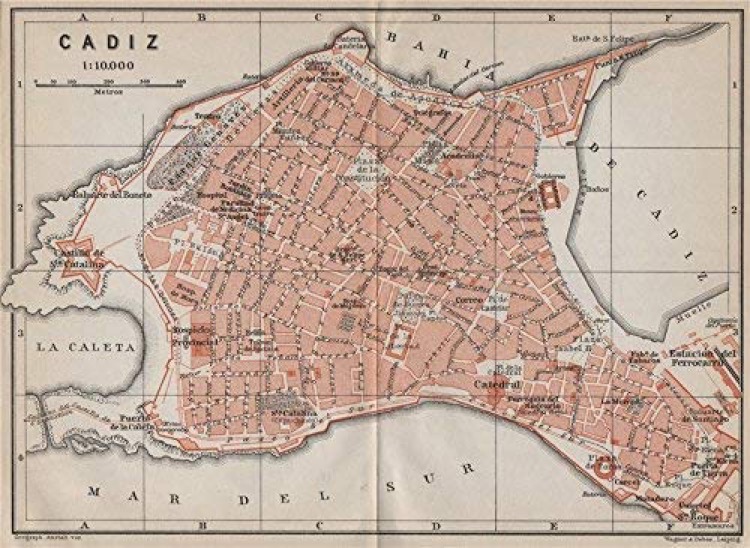
In 2014 we decided to visit Cádiz for Christmas and the New Year. We visited one of the oldest cities in Europe, and at the same time we learned more about how the Spanish celebrate one of the most important festivals in the Christian calendar.
I must admit that my intention was to rapidly describe here our visit to a city that (I foolishly presumed) had a limited role in history. I expected to have to dig deep to find a few high-points to get us from the pre-history to todays consumer society. A fine idea, but as I delved into a variety of sources I found one layer of history upon another. Cádiz is a real “been there, done that”. Phoenician, Greeks, Romans, Visigoths, Moors, the discovery of the Americas, the Catholic Kings, Trafalgar, the first Spanish Constitution, it has all happened in Cádiz. You will find here, and in a collection of related pages, quite a variety of bits and pieces, and I already apologise if my text does not read like a professional ‘novela'. So let's begin our roller-coster of a history….
Cádiz is said to be one of the oldest, if not the oldest, town still standing in Spain and probably in Western Europe.
We will start by clarifying the exact ancient name for the city:
- Gadir (גדר or Gádir), or eventually Gaddir, was the original Phoenician name for Cádiz
- In Greek the city was known as τὰ Γάδειρα or Gadeira, which some sources say is preserved in the form Cádiz or Cádix (Cádix being the plural form because the city stood on a set of islands)
- Gades, Gadesium, Gadis, and Gaddis are the Latin forms for Gadir, and later the city was called Gaditanus
- Qādis in Arabic, and some (other) sources say Hispanicised as Cádiz.
A Phoenician City
We are told by Greek writers that Gadeira was founded by the Phoenicians from Tyre (Lebanon). And today we still call people coming from Cádiz, gaditanos. Experts have put a date on this - 1104 BC, although the oldest remains in the city date from only 800 BC. We know Tyrian merchants were the first to navigate the Mediterranean and they founded colonies along the coasts of Greece, southern Italy, the northern coast of Africa, Sicily, Corsica, and in Gadeira (Cádiz).
For example experts think that they placed at the end of the island of Cádiz a temple dedicated to the god Melqart, the tutelary god or guardian spirit of Tyre. We know of only two other similar temples, one in Ibiza and the other in Cartagena.
We also know that Hannibal was a faithful worshiper of Melqart, and there is a legend that says that just before setting off on his march to Italy he made a pilgrimage to Gadir, the most ancient seat of Phoenician worship in the West.

This is a votive statue of Melqart found in 1984 on the small island of Sancti Petri, the possible location of the Melqart sanctuary. I must admit it looks a bit ‘Egyptian’ and it has been suggested that Melqart might have been originally derived from the Canaanite deity Resheph (and thus back to the Theban war god Montu).
The reality is that the Phoenician colony was established before the beginning of classical history. What we know is what the Greeks wrote several hundred years later (from 7th C BC). Those same Greek authors would also talk about the Melqart temple having two bronze pillars with inscriptions mentioning the expenses incurred by the Phoenicians in their making. The temple was later renamed by the Greeks and Romans as 'Hercules Gaditanus', and became well known as an oracle.

Phoenician coins have been found in Cádiz. They were copper and usually bore the head of the Tyrian Hercules (Melqart or Melcarth wearing a lion’s skin headdress) on the obverse, and on the reverse one or two fish and the Phoenician epigraph Agadir or Hagadir (which would have been pronounced as Gadir, and is said to have meant fortress or walled area).

We know that the region was already occupied in 3500 BC (Neolithic), and this cylindrical idol from the Copper Age (around 2500 BC) was found just along the coast at Sanlúcar de Barrameda. This type of artefact has been found all over western Andalusia.

This small jug is the only one ever discovered in the Iberian Peninsula. It originally comes from the Nuragic culture on the island of Sardinia, and probably dates from 900-800 BC. It was found in Cádiz and was certainly a Phoenician trade piece.
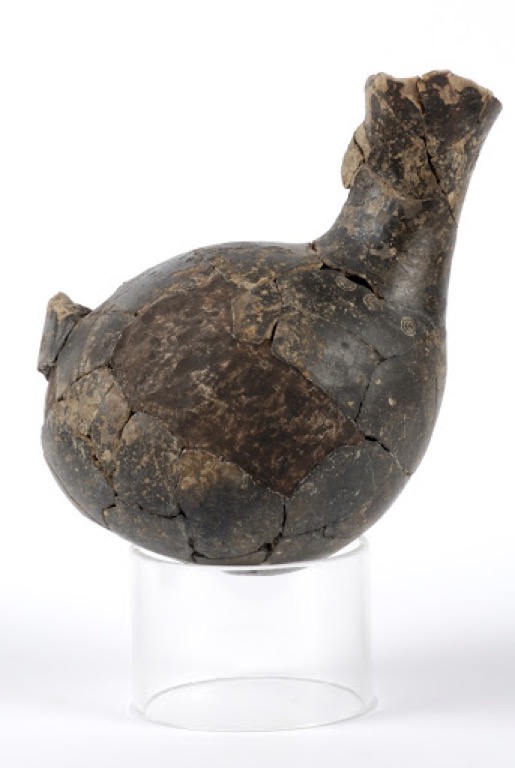
For the Greeks and Romans Gadeira was the western-most point of the known world, beyond, the seas were not navigable. The island on which Gadeira stood was traditionally identified as Erytheia, where Geryon fed the oxen that were carried off by Hercules. The Greeks were really good in creating a bit of mythology, so they promoted the idea that Hercules founded Gadeira after performing his tenth labour, slaying Geryon the monster with three heads and torsos joined to a single pair of legs. They even identified a tumulus near Gadeira as Geryon's final resting-place. Much later Cicero suggested that human sacrifices were made there, others mentioned a shrine to the cult of the dead.
The reality was that Gadeira was an archipelago of islands, and already the confusion started there. One source talks of Erytheia and Kotinoussa (Isla de San Pedro) being joined to make the island of Gadir, and another island Antípolis or the Isla de León (which was renamed San Fernando in honour of Fernando VII in 1813). Another source considered Erytheia the same as the Isla de León (but also said it might have been called Aphrodisias) and even suggested that it is now the city of Cádiz. And naturally almost everyone agrees that Cádiz was founded on Erytheia, but they appear to talking about different islands! And just to make things complete, others think that Cádiz or Gadir was really on a small separate island called Krónion at the end of Kotinoussa, where there was a temple dedicated to Kronos (or Ba’al Hammon). And when we say Krónion, we could also have said Eritía, Eforo, Filístides, Afrodisias (due possibly to the existence of a temple to Afrodita), Timeo, Sileno, and even Isla de Juno - all names given (maybe) to that small detached island. Some writers have also (incorrectly) identified the island and city as Tartessus. Herodotus (ca. 484-425 BC) placed Gadeira on the ocean, beyond the Pillars of Hercules, and near the island of Erytheia. Scylax (late 6th C to early 5th C BC) talked of two islands, one being the city of Gadeira, and being a day’s journey from the Pillars of Hercules. Eratosthenes (ca. 276-194 BC) mentions Gadeira and the 'happy island' of Erytheia being in the land of Tartessus.
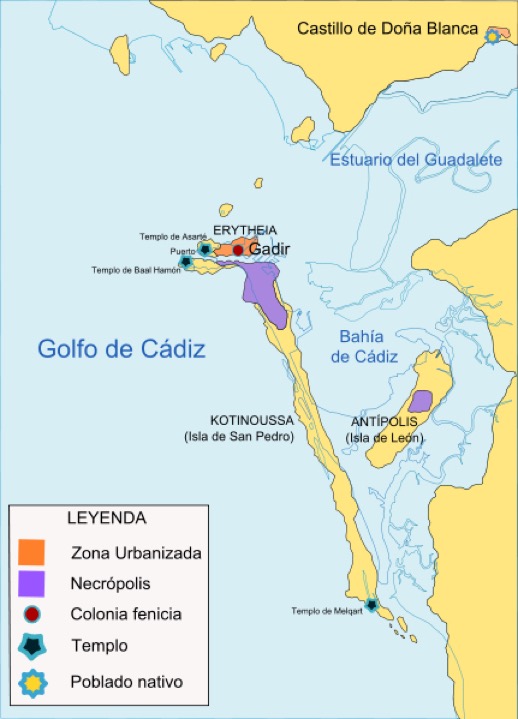
This is one of the most credible maps of Gadir. We also know today that Cádiz was made up of a smaller and a larger island separated by what could be called a natural canal. Where this was exactly is unclear, but it probably ended in the modern-day Caleta beach.
It is worthwhile eliminating the myth around Tartessus. Experts now think that Tartessus was the same as Tarshish in the Scriptures, a celebrated Phoenician emporium of iron, tin, lead, and silver. But depending upon different authors Tartessus could mean a large region of southern Spain or a town on the Baetis (Guadalquivir). The first mention of this colony was in the mid-7th C BC, but it is now believed that Hamilcar Barca (ca. 275-228 BC) destroyed it (or alternatively it was destroyed by flooding, or it just became economically insignificant). In any case it disappeared, and later writers went on to confused Tartessus with other pre-existing Phoenician colonies such as Gadir. Possibly as early as the 4th C BC the region (including Cádiz) was 'known' by its people who had their own culture and their own Tartessian language. We also know these people were important trading partners of the Phoenicians, but Gadir was not Tartessus.
Today we know that there were more than a dozen Punic-Phoenician shrines along the coast between Algeciras and the mouth of the Guadalquivir, and according to Roman sources they were the only shrines in the entire Iberian peninsula, which highlights the role Gadir played in maritime traffic and trade.
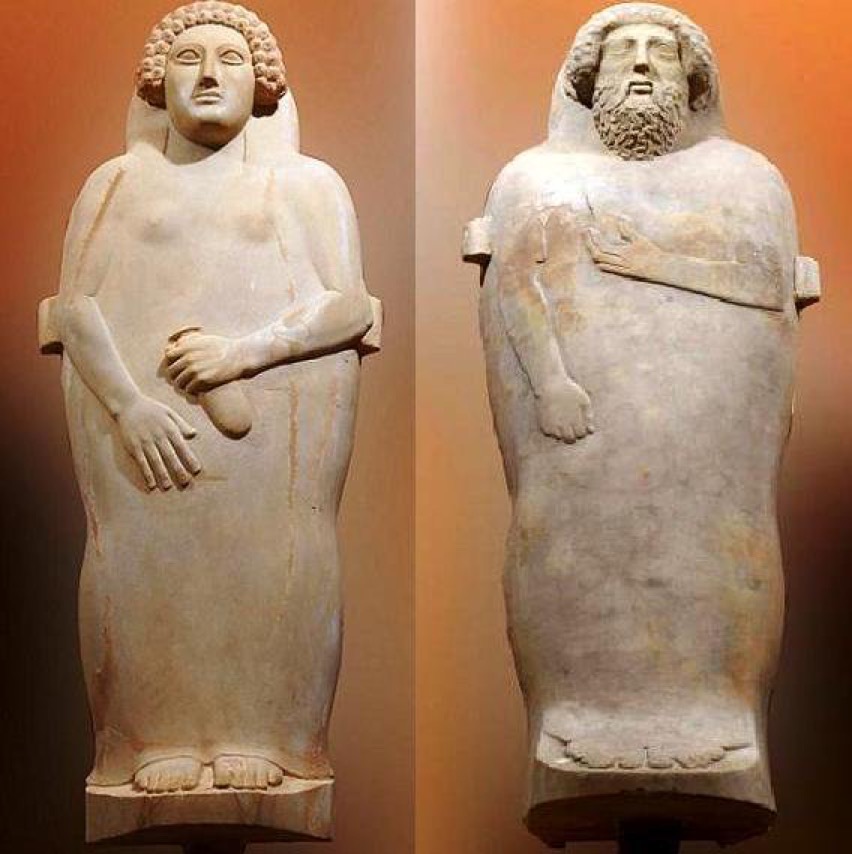
Here we have two sarcophagi in white cut and polished marble. They are more than 2 m long, and date from around 400-470 BC (Punic period or peoples from Carthage). The male sarcophagus was found 1887 in the Necrópolis de la Punta de la Vaca, an area that was being cleared for an International Maritime Exhibition and later for the construction of a shipyard. The sarcophagus of the 'Dama de Cádiz' was found in 1980 in C/Ruiz de Alda, also in Cádiz.
These two sarcophagi are major finds by any standards, and the first find was responsible for the founding of the local Museum of Cádiz. The technique used is said to be Greek or Hellenised Phoenician. The male figure with neat hair and a beard, is holding a pomegranate in his left hand and a painted crown with flowers in his right hand. Other experts have suggested that the male figure has an Egyptian-looking headdress and curly beard, and is holding a heart not a pomegranate. The female figure has a young face and possible would have had reddish hair. I’ve read that the body in the sarcophagus might well have been male. Experts think that the sarcophagi would have been imported (possible from Sidon in the Lebanon) and used by an important gaditanos family.
Before moving on let us stop for a moment to wonder at what the Phoenicians did in Gadir (Cádiz). Some think that they used the town as a base for exploring the Atlantic, and for visiting far away places such as the British Isles.
We do know that they traded in amber and tin with the Greeks, but we still do not know for certain where they got the amber. Amber was worth its weight in gold (it was considered to have magic, curative, and esoteric properties), and the best supplies were in the Baltic (90% of all amber came from the Samland peninsula), but did the Phoenicians travel such long distances?
Supplies of tin were more abundant, but some have suggested that the Phoenicians might have been able to obtain both tin and amber from the Cassiterides or ‘Tin Isles’ i.e. Great Britain. At the time (around 430 BC) these islands were said to be some way off the northwest Iberian coast. The reality was that Gadir went to great lengths to keep its tin trade a secret. The Greeks only knew that tin came to them by sea from the far West, whereas it actually came from both Galicia and Cornwall. There is even a story that says that one vessel was followed to find the location of the Tin Isles, but the pilot wrecked his ship and was reimbursed for his losses from the public treasury.
Some very recent work on amber has shown that (a) amber from the Baltic had already arrived in the Iberian peninsula even in pre-history times, that (b) there were some domestic sources of amber, that (c) some Neolithic examples of amber in Gadir actually came from Sicily, and finally (d) that Baltic amber did exist in the Gadir region and was certainly traded by the Phoenicians.
We should also not forget that while the tin trade with the British Isles was a reality, nevertheless the arrival of the Phoenicians was probably motivated by the fact that Gadir was close to the mineral-rich Huelva district and Guadalquivir valley. We also know that tin from Cornwall was smelted with Spanish copper to make bronze ingots that could then be traded in the eastern Mediterranean.
Concerning silver we are on very safe ground. The Phoenician trade in silver can be traced directly to Gadir, and the rich silver mines at Aznalcóllar (north-west of Sevilla) and the gold and silver mines in the mountains of Huelva (the famous inland region of the Rio Tinto). We are talking about serious mining operation, with the last deposit of silver yielding 30,000 tons in 1887. An analysis of the slag at the Aznalcóllar site indicates that during the Iron Age they extracted more than 6 million tons of silver, and there is an abundance of evidence that the Phoenicians were present there.
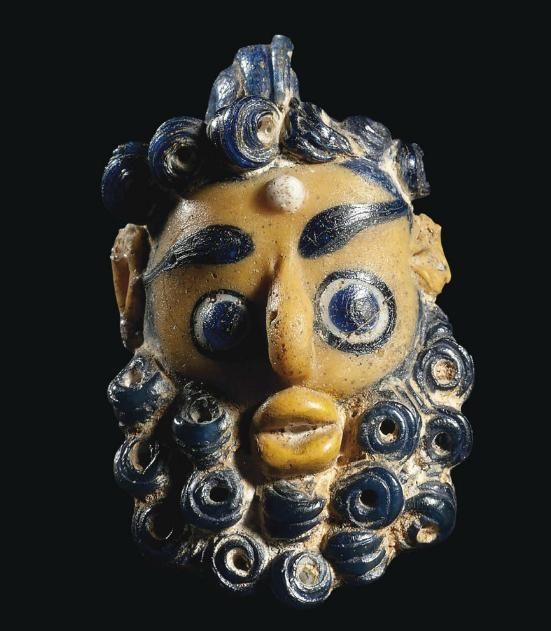
A Carthaginian glass head pendant, ca. 5th - 4th C BC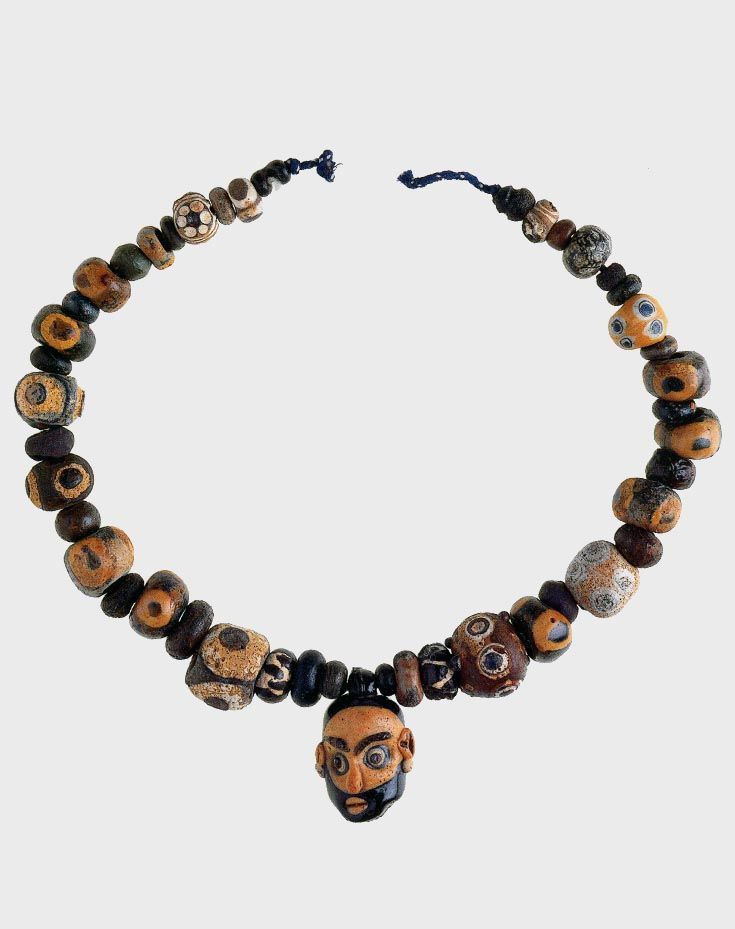
A Phoenician glass eye bead necklace, ca. 7th C BC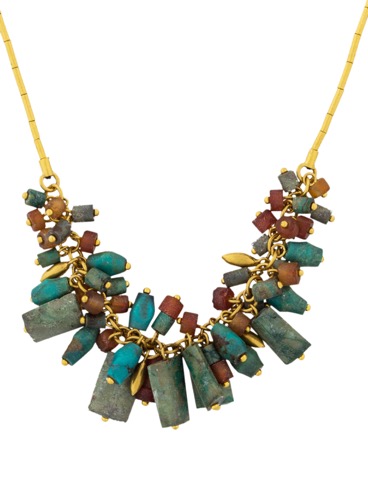
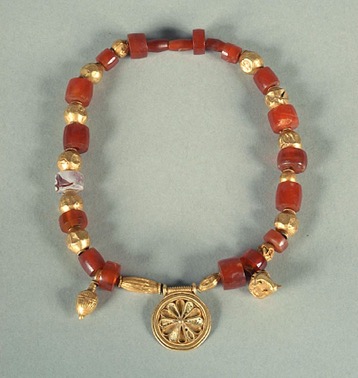
Above we have a Phoenician gold and turquoise bead necklace and an amber necklace. Phoenicians were skilled in ‘repoussé’, ‘cloisonné’ and 'filigree', and by 700 BC they had workshops in places such a Byblos, Sidon, Tyre, Carthage, Tharros, Syracuse, and Ibiza.
Gades was one of the most important Roman cities
Cádiz certainly must have changed hands again after the Battle of Alalia (sometime between 540-535 BC) after which it is said that Carthage became the unquestionable owner of the Western Mediterranean, and the city fell into decline. The Carthaginian Empire might have known quite well where Gadeira was, but it was during the Punic Wars (264-146 BC) that we find mention of the precise location of the city. We know that the city was conquered by Hamilcar Barca during the First Punic War (264-241 BC), and was used as a depot by Hannibal (ca. 247-181 BC). We also know that the city surrendered to the Roman General Scipio Africanus (236-183 BC) in 206 BC. In fact Gadir was the only city in the region to have resisted the Romans through to the final departure of the Carthaginians from Spain in that same year (Second Pubic War between 218-201 BC, see also the Battle of Ilipa in 206 BC). Some experts have noted that under these circumstances Gadir became the last refuge of the Carthaginians, and they certainly prospered through the thousand and one occasions to trade and barter. Once ‘conquered' Gades obtained civitas foederata status, which allowed it to maintain its political and economic autonomy, and not pay taxes. Under the Romans Gades flourished as a port and naval base, and Julius Caesar (100-44 BC), during a visit to the city, bestowed Roman citizenship (civitas) on all gaditanos in 49 BC.
The Greek Strabo (64 BC to 24 AD) placed the city at about 70 stadia from the mouth of the Baetis (Guadalquivir), and about 750-800 stadia from Calpe (Gibraltar). The Roman Pomponius Mela, who was born in Tingentera (now Algeciras) and who wrote around 43 AD, said that the island was divided from the mainland of Baetica by a narrow strait of about 1 stadium wide (ca. 185 m), which is now spanned by the Puente Zuazo. The length of the island was estimated at 100 stadia (18.5 km), and width varied between 1 stadium and 3 mille passuum (4.5 km). The city was on the west side of the island and was considered small in comparison with its maritime importance. Even when the Romans had built the ‘New City’ or 'Double City', Balbus (early 1st C BC) still said that it did not exceed 20 stadia in circumference and was not densely peopled (because most people were away at sea).
The city derived it wealth from commerce, it was known as the great western emporium of the known world. Firstly we should never forget the Cádiz has always been a fishing port, exploiting fishing banks off the African coast. Often we talk about other exotic commercial practices, but we should never underestimate the continuous presence of the fishing fleets and the associated salazones (salted products). Tuna was said to be fatter in the Atlantic, and it was also said that tides in the bay of Cádiz produced oysters and shellfish of superior size and quantities to that in the open sea. There is good reason to suppose that after the arrival of the Romans Gades continued its commercial and trading practices without interruption. We still have to remember that Gades was still a very small island community sitting on Erytheia (see the plan above), and it was in this period that the Caleta canal was bridged to allow an additional area to be built (bringing the city out to the present-day Puertas de Tierra and adding another 4 km to the perimeter of the city). The whole area around the Guadalquivir developed its farming activities, using prisoners-of-war as slaves. And as was the Roman habit, possession of land became a major sign of power and social prestige.
Already the rich dwelt in villas outside the city, either on the mainland or on the smaller island “resorts” such as the Trocadero and Saint Sebastian in what is now called Puerto Real. During a census taken under Augustus (63 BC to 14 AD), we know that the city was home to 500 equites (a wealthy upper class), and thus rivaled Patavium (Padua), and even Rome itself. Gades was also accorded the status of municipium with the title of Augusta Urbs Julia Gaditana, and became one of the four conventus juridici of Baetica. Some authors have rightly pointed out that despite Gades being an important city, it remained a working port. It did not acquire the majestic social architecture of the three great Andalusian Roman settlements: Itálica (outside Sevilla), Baelo Claudia (on the beach of Bolonia), and Acinipo (near Ronda). On the other hand Gades was the end point of the famous Via Augusta (created between 16-13 BC), the principle Roman road crossing all of Hispania, and joined to the Via Domitia. And it did have its theatre, aqueducts (getting rid of the old Phoenician cisterns), necropolis, etc. When the Romans left Gades the aqueducts failed and were not maintained, and the city reverted to the use of cisterns through to the mid-19th C when a mains water pipe was laid. In addition plenty of Roman coins have been found in Cádiz, even if only one has the epigraph MUN (for Municipium) on the obverse, and Gades with a fish on the reverse. All the others had the insignia of Hercules, and naval symbols, and the names of successive patrons of the city, e.g. Balbus, Augustus, Marcus Vipsanius Agrippa (64-12 BC), and his sons Gaius Caesar (20 BC to 4 AD) and Lucius Caesar (17 BC to 2 AD), and the emperor Tiberius (42 BC to 37 AD).
We mentioned Balbus, and one of the signs of the importance of the city of Cádiz is the treatment given to its eminent citizens. Balbus actually names two different people, firstly Lucius Cornelius Balbus, the Elder, often called Gaditanus, went to Rome in 71 BC and Roman citizenship was conferred on him. He knew well the Roman general Crassus, the statesman Julius Caesar, and Octavian, the first Roman Emperor. He was the first non-Italian native to attain consulship. The second person was Lucius Cornelius Balbus, the Younger, who also became a Roman citizen at the same time as his uncle. He also later became proconsul of Africa, and later still became Pontifex (the high priest of the College of Pontiffs who were the highest ranking priests of the state religion). It was he who built both the New City of Gades and the harbour Portus Gaditanus on the mainland (now Puerto Real), as well as the bridge between them.
We conclude the Roman period of Cádiz by noting that many authors of the period recorded that the city acquired great wealth, and that lead naturally to luxury, and later to great immorality. For example there is ample evidence that Cádiz was best known in Rome for its cookery and highly erotic dancing-girls.
Below is a 1st C AD Roman relief often used as evidence of the existence of belly dancing (using a very broad definition). Roman authors talk about hip articulation, shimmies, languid arm movements, and the zill-playing (finger cymbals) of female dancers from the old Phoenician and Egyptian cities, and Gades is specifically mentioned.
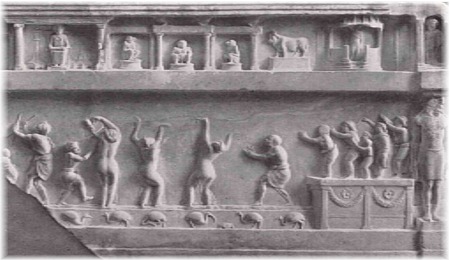
Below is a small jug made from rock crystal, and dating from the 1st C AD. It was part of a set of rich grave goods made in the same material.
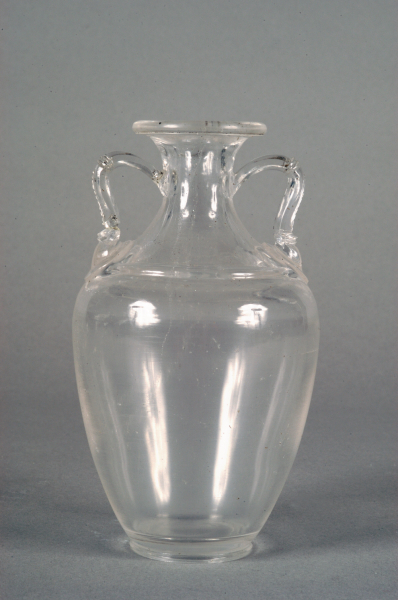
Below is a large Faience urn, dating from the 1st C AD. It is similar to others found in Cadiz.
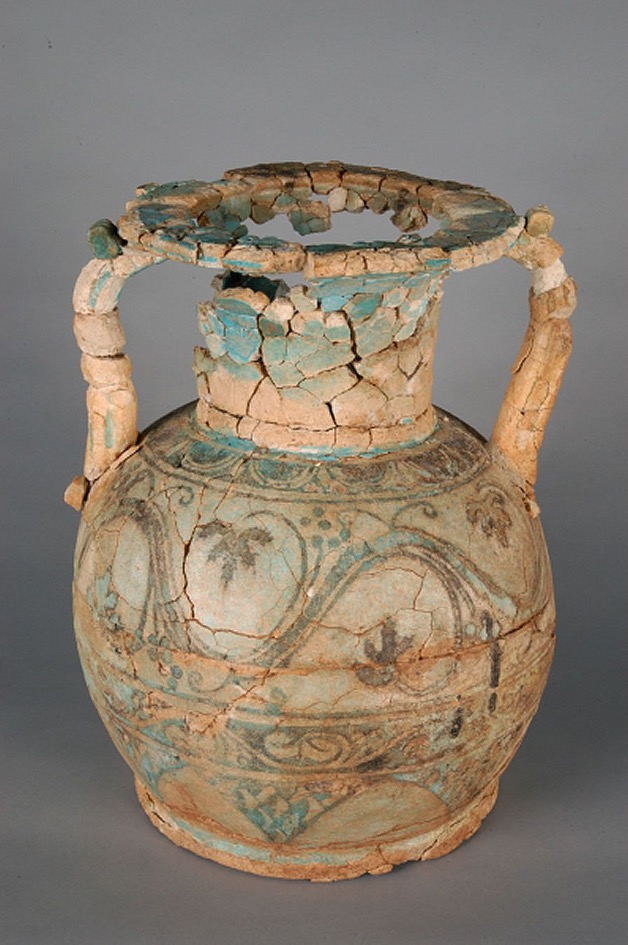
Below a collection of Roman coins covering the period Augustus (63 BC to 14 AD), Claudius (10 BC to 54 AD), Adrianus (113-193 AD), Gallienus (218-268 AD).
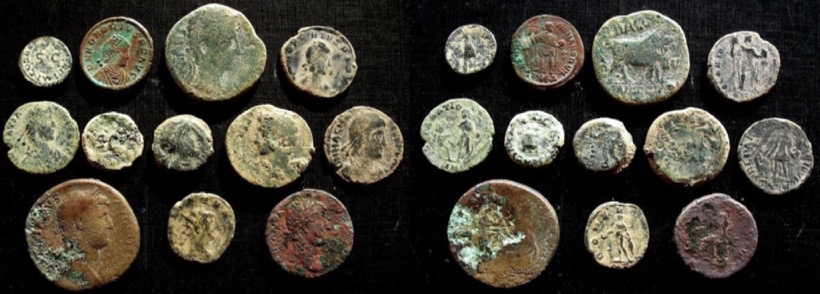
The Vandals and Visigoths arrive (as do the Byzantines)
As you can imagine the history of Cádiz is typical of a city marked by its strategic military and commercial situation, sitting between the Atlantic Ocean and the Mediterranean Sea. Cádiz was not able to avoid the crisis provoked by the decline of the Roman Empire in the 3rd C, and most guide books simply tell us that the city was captured by the Visigoths in 410 AD (the same year they sacked Rome). They also tell us that the Visigoth occupation of the Iberian Peninsula lasted until the arrival of Tariq ibn Ziyad in 711.
In one of the more complex written histories of Cádiz the author subtitles this period as ‘Decadencia y Ruina'.
Was it that simple? The 4th C AD was considered by all as one of peace and relative prosperity. Still today we can find and excavate, in the region around Cádiz, luxury Roman villas that date from this period. But as one author put it nicely, Gades was one of the cities that profited most from the Roman Empire, and thus it was one of the first to suffer. Although the same author also noted that it is impossible to separate the decline of Gades from the urban decadence and decline that hit the entire western Empire. There was a profound demographic crisis in the Roman Empire, that affected maritime traffic, and resulted in the total abandon of Atlantic routes. The result was Gades lost most of its commerce, and thus its source of riches and opulence. Municipal institutions were hit, the quality of water and the cleanliness of the town were affected. The link between the town leaders and the people was broken. The only thing left was the local fishing. And it was also mentioned that almost all maritime commerce became impossible due to both pirates and the poor condition of the port. The New City built by Balbus was in part abandoned, except for an area around the theatro Romano.
Before the arrival of the Visigoths, we must look first to another East Germanic tribe, the Vandals. They had slowly but surely been pushed west by the Huns, and in 409 they had crossed the Pyrenees and settled in Galicia and Baetica. Baetica, one of the three Imperial Roman provinces in Hispania and approximately corresponding to modern Andalusia, was settled by the Vandal group called the Silingi. But they were constantly attacked by the Roman-sponsored Visigoths (417-418), so they voluntarily subjected themselves to the rule of Gunderic (379-428), King of the Hasding Vandals. In 428 they followed his successor Genseric (ca. 389-477) and relocated in North Africa, and by 439 the Visigoths had taken Carthage (the main granary of the West) and established a kingdom that included Sicily, Corsica, Sardinia and the old Roman African province. In 455 they even sacked Rome, but finally their kingdom collapsed in the Vandalic War (533-534). Genseric has been called the single most disruptive element in western politics until his death in 477. Many of the histories just mention this “relocation” of the Vandals into North Africa, but the reality was somewhat different. In fact Bonifacius, the Roman governor of Africa had rebelled against Rome, and was facing an invasion by imperial troops. He made the mistake to ask Genseric for help. So he cross the straits of Gibraltar with 80,000 people and did not intend to go back. By 439 Geiseric had taken Carthage, made it their capital and settled it.
Below we can see the different settlements in the Iberian peninsula, circa 418, with the Visigoths in red. Their capital was Toulouse.
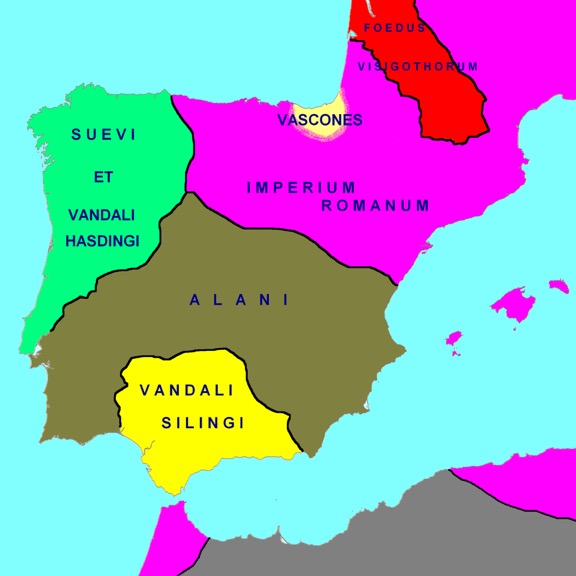
Below we have the different settlements in the Iberian peninsula, circa 476, and we can see how the Visigoths (in red) expanded into Spain.
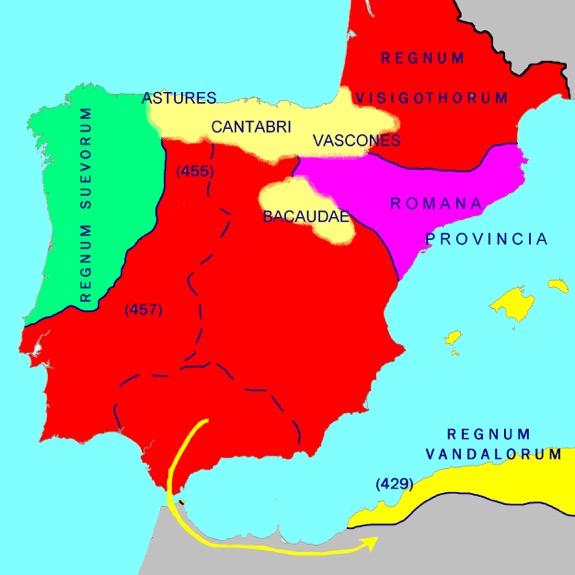
With the Vandals taking Carthage, the Romans sent the Visigoths into Hispania. Ataulf, king of the Visigoths, had already agreed to leave Italy after the sack of Rome in 410, and he had taken as his consort Galia Placidia, the half-sister of the Roman Emperor Honorius. So it was probably not difficult for him to be convinced to attack the Vandali, Alani and Silingi in the Iberian peninsula. By 476 the Visigoths had control over Hispania Baetica, Carthaginiensis (another old Roman province) and southern Lusitania. In conflicts with Franks and the Burgundians the Visigoths later lost their lands in France, and in a conflict with Justinian I, the Byzantine (East Roman) emperor, they saw the Byzantine Empire install itself along the coast of southern Spain (Provincia Spaniae) between 552 to 624 (after they had defeated the Vandals in North Africa in 534).
During this period things would change substantially. We would see the Roman Empire disappear around 476 AD. The Visigoth king Reccared I (559-601) would convert to Catholic Christianity (see the Third Council of Toledo). The Byzantines would be defeated, and their holdings in Spain would be captured, including Malaga. And in 654 a Visigoth book of law, the Liber ludiciorum, would be completed.
We are slowing working towards the Muslim conquest of Spain, but what of Cadiz? During the conquest of the Spanish peninsula by the Visigoths and their conversion to Christianity we hear little or nothing of Cádiz. We know that Cádiz was captured by the Vandals in 426, and we also know that the fires of the lighthouse were no longer maintained. Historians tell us that a few masonry fragments are all that we have of that early city. Clearly Cádiz was captured at sometime by the Visigoths, but it is equally clear that the city entered a significant period of decline. It lost its position as capital of the province, and equally it appears to have lost its commercial and strategic importance. The open style Roman city must have contracted into a ‘typical’ small walled town. We know that in the transition between the Roman Empire and the ‘Middle Ages’ many people had to give up their basic rights in exchange for protection by important landowners. This probably also occurred in Cádiz. However the port must have remained because we also know that it was ceded by the Byzantines to Atanagildo, future king of the Visigoths, in 552, and that they supported him in deposing King Agila in 554. What happened then? Why do we read that the Visigoths 'retook' the city in 572? Why do we read that the Visigoths conquered the city in 620? Should we care? In any case we are told that until the Muslim conquest of the region, Cádiz was a backwater known only for fishermen and their salted fish.
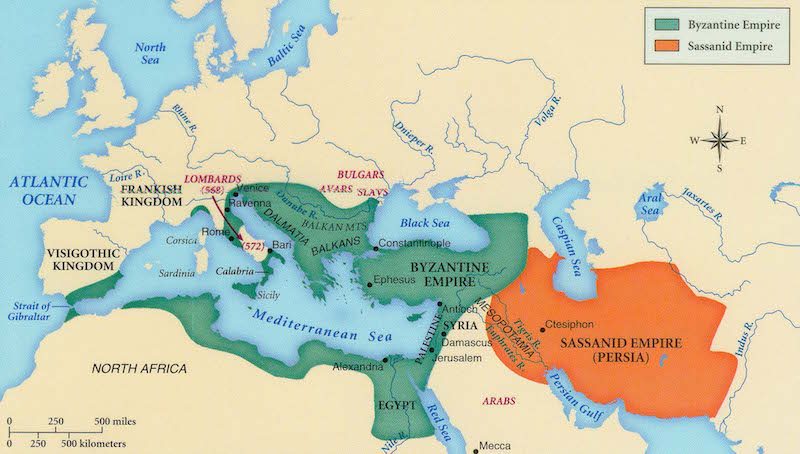
In fact we know that the Byzantines preferred to station a garrison and naval force in Ceuta with the responsibility for monitoring events in Spain and Gaul. This was sufficient to control navigation through the straits of Gibraltar and defend southern Spain against a Visigoth attack. Some experts tell us that the Byzantines fortify cities, and built a series of ‘fortified positions' (castra, castella) linked by roads. Other experts tell us that they simply exploited some existing defensive positions, and did little else. This sounds reasonable given that there is no archaeologically evidence to support a ‘Byzantine’ era in Spain (and in Cádiz). There are plenty of remains from the 6th C and 7th C, but nothing to support an Byzantine imperial occupation during that period. And we should not forget that the two key Byzantine-controlled cities were Cartagena and Málaga, so Cádiz was certainly marginalised during that time. There is some evidence to suggest that Medina Sidonia (due to it being on the inland road to Seviila) might have had some strategic value, but strangely there is little to suggest that Cádiz had the same value. Some Byzantine coins have been discovered in Cádiz and some Byzantine official weights were found in Algeciras. Both being coastal sites with good harbours would suggest that they were closely connected with Septem (modern Ceuta) with its naval and land forces. And there is some evidence to suggest that guardsmen from Septem were based near Cádiz at the “Pillars de Herakles”. But we should not hide our eyes to the reality. One author concluded that at the end of the 8th C Cádiz had become both insignificant and un villorrio, a dump.
Just to prepare for the Muslim conquest of Spain we are going to mention Mauretania, an area covering Morocco, and the Spanish enclaves of Ceuta and Melilla. A Berber kingdom, they fell first to the Vandals in the 430’s, before becoming part of the Byzantine Empire. There are some indications that the Byzantines ‘attached’ Cádiz to Mauretania, giving it some form of administrative status and calling it Mauritania Gaditana. In any case the Byzantine province was finally lost to the Umayyad Muslim conquest of the Maghreb around 698 (although they regained their independence in the Berber Revolt of 743).
The Arab Conquest


This is not a history lesson, but an attempt to follow the evolution of the city of Cádiz from its creation through to modern day. The first map above shows the gradual expansion of the Muslim Empire between 622-750, and the second map shows the Iberian peninsula in the year 1037.
The Berbers had raided the southern coast of Spain for sometime, but in 711 they crossed Gaditanum fretum (straits of Cádiz) with a large force. A different source said that an exploratory force embarked at Tarifa in July 710 and headed towards Algeciras to prepare the invasion. The central figure was a Muslim Berber, Tariq ibn Ziyad, under the orders of the Umayyad Caliph Al-Walid I. We know very little about this period, neither the actors in the drama, nor the exact dates and places of events. The beginning of the conquest is often associated with the Battle of Guadalete (July 711) between the Christian Visigoths and the Muslim Arabs and Berbers. We do not know where exactly this battle took place, but some people call it the Battle of Jerez de la Frontera. However other experts place it on the Guadalete river (sometimes called Rio de los Muertos), which runs into the Bahía de Cádiz at El Puerto de Santa Maria, just south of the city of Cádiz.
The reality is that little is really known about what happened, and even the year of the invasion is uncertain, e.g. 711, 712 or even 714. Many experts place the Battle of Guadalete somewhere near Medina Sidonia, others tell us that the battle was between 100,000 Visigoth troops against 187,000 Muslim troops (despite mentioning that only 7,000 troops landed!), and others tell us that Roderic lost because of the deceit of Sisebut. In any case the Muslims took most of southern Spain with little resistance. But inland and in the north Visigoth resistance continued, and it would be another 14 years before the Arabs had truly secured the victory of 711.
Once the battle was won, Cádiz was just a short march away. It was renamed Yazirat Qādis, isle of Qādis, and it would again emerge as an important trading port for both the Almoravid (11th C) and Almohad (12th C) dynasties. We are not talking about a Córdoba, Sevilla, or Granada, but Qādis did get its mosque with a minaret (even if it was a converted Roman building). They even rebuilt the old Roman theatre. Qādis became a small, but vital, market city-port. Some experts have suggested that Qādis could have become, in one way or another, the first Muslim stronghold. Some even have suggested that Qādis actually helped with the disembarkation. In any case things did not change too much. Qādis remained a fishing port, and its principle activity was preparing and exporting salt and salted fish. Until the late 9th C Qādis was included in the region Saduna with Medina Sidonia as the 'capital' (at least until 844 when Medina Sidonia was destroyed by the Normans). From 1034 Qādis was included in Taifa de Arcos, and in 1069 it was included in the Taifa de Sevilla. Some experts suggest that Qādis fell into decay, other suggest that things progressed slowly but surely. What is sure is that the region continued to be known for its salted fish, but it also exported from it orchards, and the region of Jerez became known for its cereal, grapes and olives. They say that Qādis lived well, but was not able to develop new avenues of prosperity. For example in the mid-9th C Qādis paid an annual tax of 50,600 dinares, as compared to 120,000 dinares for Córdoba, 110,000 dinares for Ilbira (Granada), but more than the 35,000 dinares for Sevilla, and much more than the 19,000 dinares of Algeciras. However it is also true to say that Qādis was excluded from the major commercial networks of the period. Reports also say that Qādis was again captured by Abd al-Mu’min, first Almohad Caliph, in 1147, and came under the direct administration of the Almohad Empire.
One reviewer of the period simply jumped forward several hundred years claiming that Cádiz would only awake again when the 15th C Portuguese explorer Gil Eanes rounded the Cape Bojador (a headland on the northern coast of Western Sahara) in 1434. Other experts are a little more positive about the evolution of Qādis under Muslim rule. We have already mentioned that a mosque was built, and the Roman theatre was rebuilt. They also substantially reinforced the defensive walls of the city. Because of its limited size Qādis was compared with ports of Ceuta or Tunis, but it was also recognised that it was a strategically important land, sea and river communications hub, and one that was much desired by the Christians.
Before moving on it is worthwhile looking at the relationship between Qādis and the so-called Mozarab community in Spain (although the term ‘Mozarab’ was not used at the time). The Mozarabs were Iberian Christians, mostly Roman Catholics of Visigothic rites, who lived under Moorish rule in Al-Andalus). The reality was that Spain evolved as a mix of Muslims, those who had converted to Muslim (Hispano-Muslim), and the remaining Christians. Given that Mozarabs were usually urban dwellers, slaves, labourers, artisans, shopkeepers, etc. we can easily imaging that in Cádiz many people continued to be Christians throughout the Arab occupation. Equally we know that the agricultural areas around Cádiz must have benefited from the introduction of cisterns, piping, and underground canals for improved irrigation. New areas could be cultivated, new crops introduced, and the productivity of the land was improved. We also know that Islamic law at the time had less restrictions upon the transfer of land, making it easier to bring uncultivated fields back under cultivation (land left uncultivated could be confiscated and resold). Land used for fruit and vegetables was lightly taxed, even if the Mozarabic peasantry paid more taxes. The Arabs also are known to have introduced the pomegranate, the date palm, better varieties of fig, lemons, lime, and sour orange, into the rich Guadalquivir valley. So lots of suggestive ideas, but the reality is that I can not find any major references to this period. We can only conclude that Qādis survived more or less well, and waited for better times to return. And return they would!
Culture: Visigoths or the Muslim Invasion
This is going to be a kind of “aside” to the chronological review of the history of Cadiz. In my meanderings I came across this analysis in Spanish, and I include it here as best I can (unfortunately I cannot find the original reference).
The starting position of the author was that when talking about the Muslim invasion of Spain we tend to think of Alhambra, when in 1333 it became the royal palace of an Emirate that emerged in 1238. The more thoughtful of us might mention the Caliphate of Córdoba which ran between 929-1031. But we tend to ignore the sack of Visigoth Spain after the invasion of 711. In the below text the author uses the texts of Muslim writers and historians of the period. What did they write about the Visigoth Spain that they found in the 8th C? In addition, the reality of a Islamic invasion is quite topical today.
Let us set the scene. By the time the Visigoths began to take over Spain from the Latin (or Western) Roman Empire in 415, they had been serving the empire for generations as soldiers, generals, and even political leaders. They were culturally Romanised, and considered themselves the continuators of the empire, not its destroyers. This was not the case with the Muslim invaders, whose culture was very different from that of Hispano-Romans and Visigoths. The Visigoths did not make their faith the dominant religion of the land, but instead converted to the existing and prevalent religion, Catholicism. Islam did the opposite. Unlike Muslims, the Visigoths had not been motivated by their religious faith to make the land submit to their religion and make those who did not convert pay a particular tax. The Muslims imposed a tax specifically designated, as Maliki texts from the Middle Ages remind us (the Maliki school of Islamic law, second only to the Hanbali in its rigorous understanding of Islam, was the school of law prevalent in Islamic Spain), to humiliate the Visigoths and remind them of their submission. The Visigoths initially professed a form of Christianity (Arianism) that, though considered a heresy by orthodox Christians, had been founded by a Christian bishop and was therefore closer to orthodox Christianity (Catholicism and Greek Orthodoxy) than Islam. The Visigoths were linguistically close to the Hispano-Romans, since they spoke an Indo-European language, and their leaders and eventually the people at large adopted Latin. The Islamic invaders spoke a Semitic language and instead imposed it on the land. All these factors made it easier for the Visigoths to undertake the cultural and ethnic unification of Spain once they abandoned Arianism in 589 and converted to the religion of the majority of the population, Catholicism.
Medieval Muslim chronicles tell of the astonishment experienced by the Islamic warriors at the splendor of such Visigoth cities as Toledo, Seville, Córdoba, and Mérida. In a chronicle attributed to Abu Ja’far al-Kortobi, it describes Spain as a land “filled with treasures of all kinds, whose inhabitants would make very handsome slaves, a country abounding in springs, gardens, rivers, and a land yielding every description of fruits and plants”. The Muslim leader Tariq ibn Ziyad, who lead the invasion in 711, found “books treating of the manner of using plants, minerals, and animals, advantageous for man, besides many wonderful talismans, the work of ancient philosophers, and another work on the great art, and its roots and elixirs; all these precious objects, together with an immense quantity of rubies and other coloured gems, stored in golden and silver urns of beautiful workmanship, and ornamented with large pearls”. The craftsmanship of the bejeweled sandals of the Visigoth king Rodrigo was such that when found after the Battle of Guadalete they were valued at one hundred thousand dinars. One of the earliest Muslim chronicler of Islamic Spain recounted the fate of a wonderful bridge over the Tagus river “it was so well built that there was nothing like it in the whole of Spain”, and during the Islamic conquest of Toledo a Muslim leader ordered it destroyed. Another Muslim chronicler described the former Visigoth royal palace in Córdoba as full of “wonderful remains of the Greeks, Romans, and Goths” and “the interior apartments were so magnificently decorated as to dazzle with the beauty of their ornaments the eyes of beholders”.
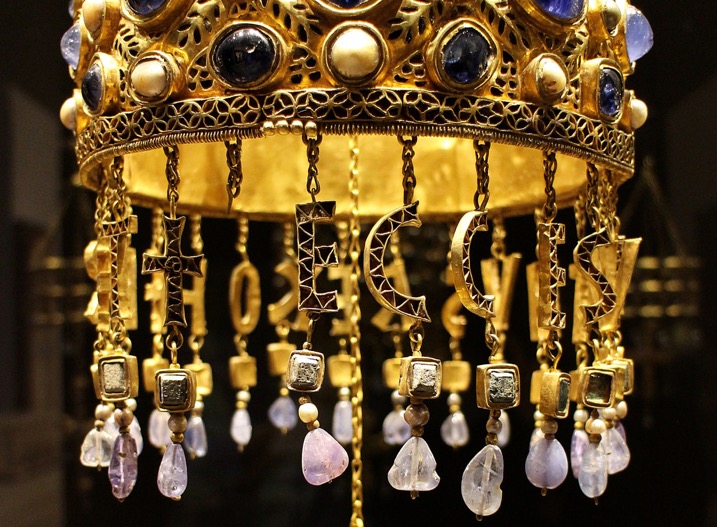
Above we have the votive crown of King Reccesuinth (649-672), the Visigoth King of Hispania. It is one part of the Treasure of Guarrazar.

Visigoth gold cross set with precious stones, 7th C.

The horseshoe arches derive from the Visigoth architecture and the floral decoration from both Roman and Persian traditions. They are combined with Islamic calligraphy and geometric patterns.
Today we tend to ignore the fact that the sacking of Visigoth Spain was stupendous, to judge from the Arabic accounts, the corroborating Christian accounts (such as the Crónica mozárabe of 754 and the Crónica bizantina of 741), and the material evidence provided by the treasures that some Visigoths managed to hide from Muslim hands. One work tells of the immense booty taken from Spain by the conqueror: besides the children of the Gothic kings and thousands of male and female slaves, they took gold diadems, vases of gold and silver, jewels “beyond computation and all sorts of novelties” and a stupendous ‘jeweled table', the craftsmanship of which Muslims had never seen before, made of “pure gold and silver mixed”, ornamented “with three rows of inestimable jewels, one of large pearls, another of rubies, and a third of emeralds”. Nothing, the Muslim author concluded, “could be conceived more rich or beautiful”. What was this “table,” as the Islamic conquerors called it, which they carried away after the sacking of Visigoth Toledo? It was in fact part of the altar furnishings of the great cathedral of Toledo. When they left Spain to go back to home, they amazed “the inhabitants of the countries through which they passed with the immense treasures they carried, treasures the like of which no hearer ever heard of before, and no beholder ever saw before his eyes”.
Even after their conquest of Spain, the invading Berbers continued to lead a primitive, nomadic life, taking along wherever they went their wives and children. According to chronicler Ibn al-Abbar, it was Abd-al-Rahman I (Emir of Córdoba in 755) who first managed to make them build villages and live a sedentary life. The early years of Muslim rule in Spain are usually forgotten by those who focus on the brilliance of the Caliphate of Córdoba (929–1031), a product of both the increasing Islamisation of the more cultured Hispano-Romans and Visigoths who remained under Muslim rule and of Spanish Islam’s assimilation of Hispano-Roman, Visigoth, and Greek architecture, science, and medicine. The great churches, the stupendous bridges, the colossal aqueducts, all the features of Hispano-Visigoth civilisation astonished the rude Berbers, if not their Arab masters. It must be said that the Arab elite might have been exposed already to a similar culture during their conquest of the Greek Orthodox Roman Middle East and North Africa in the 7th C and 8th C. They marvelled at the roads that still traversed Spain in all its length. They considered Visigoth Seville, where Saint Isidore had lived, “the abode of the sciences”. They marvelled at engineering works they had never seen before, such as the Roman aqueduct of Cadiz, “which conveyed fresh water from a spring in the district of the idols to the island of Cadiz, crossing an arm of the Ocean”, or the Roman aqueduct of Tarragona, which “conveyed the water from the sea to the city by a gentle level, and in the most admirable order, and served to put in motion all the mill-stones in the town, the whole being one of the most solid, magnificent, and best contrived buildings that ever were erected”.
Over time, the pillaging, destruction, and abandonment erased almost completely the cultural vestiges of a nascent civilisation. We have very few literary records of Visigoth Spain, “the debacle caused by the Arabic invasion carried away all official documents”. This architectural, literary, and iconographic disaster cannot be attributed to the Visigoths. Already highly Romanised by the time they entered Spain, they were interested in preserving the symbols of Roman power, because they considered themselves its inheritors. Thus we have records of the Visigoths’ practice of sculpture and of the great artistic centre in Mérida. Little remains because of the centuries of iconoclastic Islamic domination. The Visigoths’ assimilation and adaptation of the preexisting Roman and Hispano-Roman Christian art, and especially of the immensely rich Greek Roman Empire’s art, were ruptured by the Muslim conquest, as was the Visigoth kingdom’s assimilation and adaptation of Greek science. On the other hand, Muslim chroniclers attest to the iconoclastic zeal of early Muslim rulers, such as the celebrated Abd-al-Rhaman I, founder of the Umayyad Emirate of Córdoba. “He would take all the bodies which Christians honour and call saints, and he would burn them. And he would burn their beautiful churches. And in Spain there were many and very magnificent churches, some built by the Greeks and some by the Romans. Seeing this, the Christians, when they could, would take their sacred things, and would flee to the mountains”. In Spain the first mosque was built upon a Catholic church shortly after Muslim troops disembarked. Significantly, no remains of churches built prior to the Catholic Reconquest can be found today in southern Spain. Historians have observed that the destruction of the Catholic heritage was the result not merely of the religious teachings of Islam but also of a conscious policy of systematically erasing all Christian 'power signs' from “al-Andalus”. Eventually, Muslims took advantage of the nonrepresentational aspects of Hispano-Roman-Visigoth art, and for example adopted the Visigoth horseshoe arch.
The famous 'mosque of Córdoba’, a Catholic church since 1236, is a particularly good example of all this. The main facade was built out of the main facade of the torn-down church of Saint Vincent, the columns and other building materials were cannibalised from Hispano-Roman and Visigoth churches, and the alternation of red brick and white stone in the arches is a Roman technique (the opus vittatum mixtum). The horseshoe arches imitated Roman arches and the Visigoth horseshoe arch, and the mosaics are of Greek manufacture.
Finally southern Spain had a Mediterranean climate that allowed for the Greek-Roman culture of water and baths to exist. This culture was part of the Hispano-Roman life of southern Spain, inherited by the Visigoths. It was this culture that the Muslims from the arid North Africa encountered and happily took over. Thus the ‘bath culture’ of southern Spain was not a Muslim invention, as is often reported, but a feature of Hispano-Roman-Visigoth life adopted by the invaders.
Now back to Cádiz.
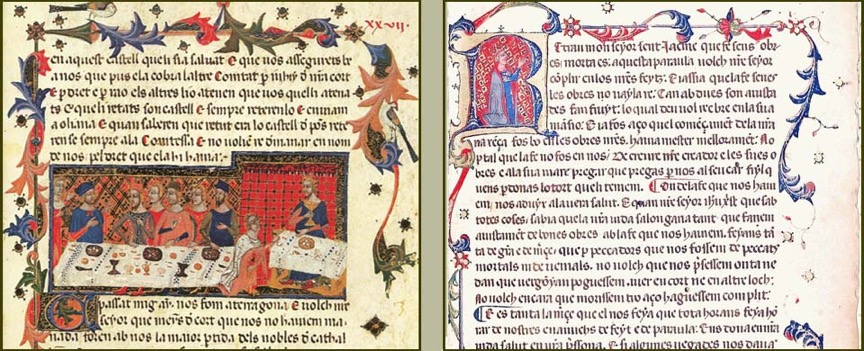
For those of you who may be interested in the chronicles of the 13th C and 14th C there are the, so-called, Cuarto grandes crónicas (in Catalan) that describe medieval Europe, and in particular the Llibre dels feits which describes in detail the conquest of Mallorca and Valencia by Jaime I (1208-1278).
The Reconquista of Cádiz by Alfonso X
Jumping to 1434 ignores at least one major event in the history of Cádiz, the reconquista of the city in 1262 by Alfonso X, el Sabio (or the Wise). I presume 'the wise' refers to his well known contributions in the fields of law, sciences and history. Essentially he continued the efforts of his farther, Fernando III, el Santo, and he conquered Jerez in 1253 and Cádiz in 1262. It is said that even at that time he wanted to not only expel all Muslims from Spain, but he also wanted to use Cádiz as a based to conquer Africa. In fact it took only two years to recapture the Bahia de Cádiz, largely because the city had been more or less abandoned after an attack by mercenaries. Alfonso X immediately started to build a new defensive wall, a new church on the place of the Mezquita, and even his own palace.
So la isla gaditana was seen both as a valuable fortress and a useful operational base to access north Africa. For this reason the city was 'rebuilt', after being left in “lamentable abandono”. After expelling the Muslims the city was repopulated with 300 people from the north, half nobles and half commoners. Later more people came into the city from Santander, Laredo and Castro. The defences of the city were also reinforced by 100 crossbowmen, and 200 lancers. In addition the king also allowed the children of gaditanos who were clergy to eat first in the church, and gaditanos who were merchants could enter and leave the city without paying taxes and could sell their produce from their homes, and on top of all that anyone bringing in merchandise for these people would play only one-third of what they would pay in taxes in Sevilla. This quickly established a “oligarquía mercantil” (mercantile oligarchy), in which the Genoese (from Genoa) quickly found their place. Recently it has been suggested that the commercial links with Genova, and to a lesser degree Venice, laid the foundations for the commercial links between Cádiz and America.
More importantly Alfonso X ceded a monopoly to the city for trade with Africa, a monopoly that was confirmed time-and-time again through to the 16th C. Pope Urban IV established the Diocese of Cádiz and built a cathedral in 1263. As they say, Alfonso X demonstrated his particular affection for Cádiz by giving it the title of “city” in 1265, and adding local mayors for Medina-Sidonia, Rota, Puerto de Santa María, Sanlúcar, Chipiona and Trebujena. As an interesting aside, during this period different cities in the region were either under the control of Castilla or of the King of Morocco Abu Yusuf (?-1286). At the time Abu-Yusef occupied Jerez, but he moved to Algeciras, and signed a peace treaty with Sancho IV (1258-1295). Times were unstable. The successor of Abu-Yusef (his brother Abu Yahya) was more aggressive, and so Fernando IV (1285-1312) decided to invade the region and attacked Algeciras and Gibraltar. Then there was the constant fighting between Alfonso XI (1311-1350) and Abul al-Hasan (1297-1351). Cádiz remained a stronghold and home to a large fleet, but it also suffered. For example in 1370 it received help with grain and money after a battle against the Portuguese who had penetrated up the Guadalquivir. Quickly following the reconquista the city obtained in 1385 from Juan I (1358-1390) an additional important exemption, e.g. they no longer needed to pay taxes to the Crown nor Admiralty. Another incredible important privilege was the so-called Privilegio Rodado, where the King basically ceded some rights, for example certain rights pertaining to the definition of a territory, the rights of jurisdiction, the economic relationships with others, the defenses of the city, and possibly some fundamental rights. Fighting was not the only problem, in 1446 an epidemic killed several thousand inhabitants.
At this time new commercial prospects were opened up with the success of the Portuguese navigator Gil Eanes in rounding Cape Bojador. It opened up the litoral sahariano and provoked the discovery of the Volta do Mar, and including Madeira, Azores, Senegal, Cape Verde, the Congo River, Guinea, Angola, and Namibia. It also lead to the circumnavigation of the globe in 1519-1522 by Magellan. Cereal, tools and hardware, trinkets, salt, copper, textiles were exchanged for slaves, pepper, ivory, feathers, and above all else gold powder. Being able to navigate the African coast removed the need to use caravans and the Muslim intermediaries. By 1518 it is said that gold worth 200,000 ducados was entering Cádiz every year.
Throughout this period the city was essentially dominated by feudal lords, namely the family Guzmán (e.g. descendants of Guzmán el Bueno). They owned lands in Sanlúcar, Trebujena, Conil, Vejer, Jimena and Puerto de Santa María. Fernando IV loaned the family the cities of Medina-Sidonia and Chiclana. Other lords ruled over Tarifa, Arcos, and Rota. There were even the occasional rumours of an independent Andalucía. However the person who stood out in that period (mid-15th C) was D. Rodrigo Ponce de Leon y Núñez (1443-1492), Conde de Arcos and Marqués de Cádiz. He was one of the principle military leaders under the Reyes Católicos during the Guerra de Granada (1482-1492). In those days titles also conferred substantial power over lands and the wealth of the city. In return he sponsored a major building campaign within Cádiz, and initiated a major expansion of the city outside its original walls. Upon his death, his estate went to his daughter, however the Reyes Católicos recovered the Duchy of Cádiz, and provided compensation in the form of a Duchy in Casares and in Arcos. In 1493 the Reyes Católicos reconfirmed all the privileges that Cádiz had received in the past (and confirming at the same time the agreements made between Cádiz and Jerez).

Isabella I of Castile, the artist is anonymous. This painting is in the Casa de los Tiros in Granada.

Portrait of Columbus by Ridolfo Ghrilandaio, however there is no evidence that Columbus ever sat for a portrait, and it would have been very unusual for the period.
Los Reyes Católicos and the Discovery of the Americas
Immediately after the conquest of Granada, Isabel la Católica decided, against the opinions of her advisors, to equip a small fleet to discover 'tierras ignoradas' (actually the destination was Japan). Cristóbal Colombo ó Colón (1436-1506) left the the port of Palos de la Frontera (Huelva province) on August 7, 1492 with three ships, the Santa María, Pinta, and Niña (Isabel had actually forced the local population to participate in the costs). Tradition has it that the Pinta first saw land ‘tierra!' on the October 12, 1492 - so the Nuevo Mundo had been discovered by three small ships who had set sail from a small port on the Andalusian coast. Colón (the Spanish name for Christopher Columbus) disembarked on an island called Guanahani (now The Bahamas), claimed it for Reyes Católicos and named it San Salvador. Colón noted that the locals had gold ornaments, that they would make good and skilled servants, and that they did not have modern weaponry. The expedition also explored parts of Cuba and the Dominican Republic.
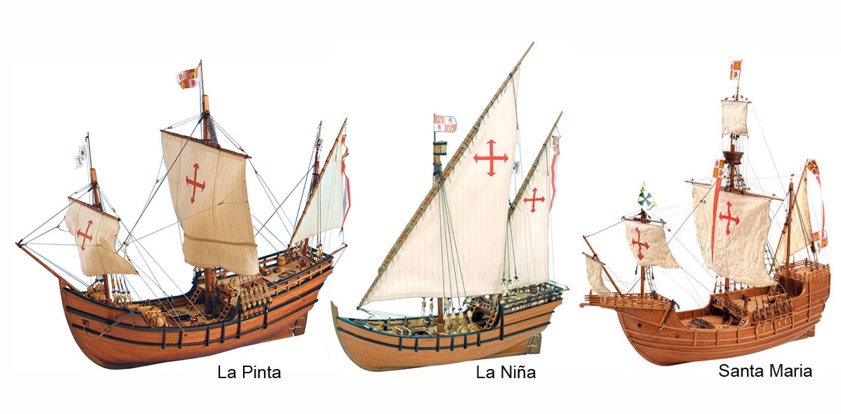
It still amazes me that Santa María was the largest of the three ships, and it was at best a medium-sized carrack, three masts, one deck, no more than 18 m long and at best 100 tons. On top of that, all three were “second-hand” and certainly not designed for global exploration. The Santa María had a crew of just 40 people, the Pinta a crew of 26, and the Niña a crew of only 24.
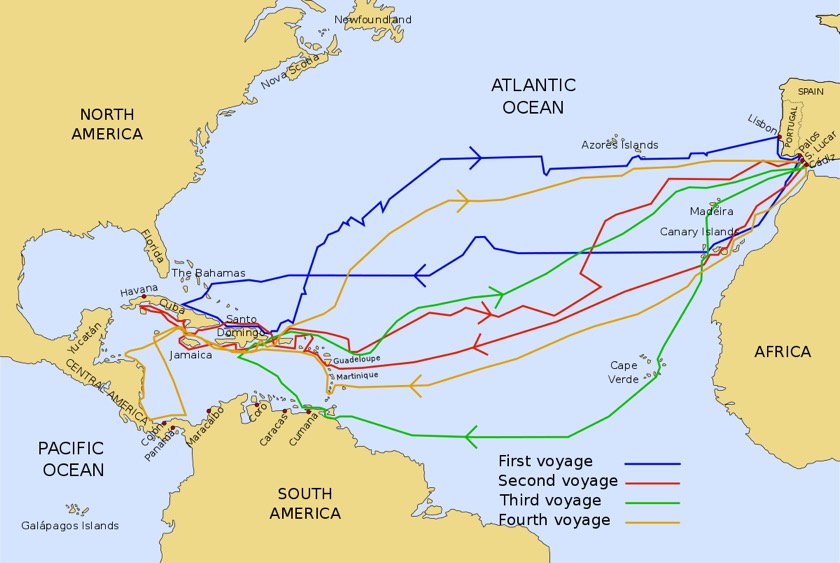
Upon their return (March 15, 1493) they were received by Reyes Católicos with all the honours. News travelled fast, and fleets were sent out from numerous countries, including Portugal and England. The second expedition (September 24, 1493) for the Americas left from Cádiz, but this time with 18 ships and 1,500 men (or 17 ships and 1,200 men, depending upon sources), and 3 missionaries. This time the trip took 3 years, and visited the Antilles, Puerto Rico, and Guadeloupe. On the third trip they discovered Tobago and Grenada, and on the forth trip they discovered Honduras, Nicaragua, Costa Rica, Panama and the Cayman Islands.
Cádiz exercised its right to be the port for expeditions to the Americas, and to be the storeroom for everything coming from the New World. Initially precious metals were taken to Sevilla, where the Reyes Católicos were in residence. A mechanism of registration was created. But it would became evident that the Guadalquivir was dangerous and Cádiz would regain its old privileges. So Cádiz prospered. It sounds as if life was always interesting. There was the Barbary pirate Barbarroja (Oruç Reis) who was active in the Western Mediterranean. Then there was the Anglo-Spanish War (1585-1604). Singeing the King of Spain’s Beard is the name given to the attack of the privateer Francis Drake (ca. 1540-1596) on the Spanish naval forces in the Bay of Cádiz. A substantial part of the fleet was destroyed, and a Spanish treasure ship was captured. And how can we forget the defeat of the Spanish Armada of the English coast in 1588. Of course we (the English) usually fail to mention that an English Armada failed in 1589, that the Spanish won the Battle of San Juan in 1595, and that they also defeated the Essex-Raleigh Expedition in 1597.
In fact it looks at times as if Imperial Spain was always involved in one war or another, and that means that Cádiz must have almost continuously been called upon. Just for fun here is a list of Spain’s involvement in wars during the period 1492 to the 1820’s:
Italian War of 1494–1498
Second Ottoman-Venetian War (1499-1503)
Italian War of 1499–1504
War of the League of Cambrai (1508–1516)
Spanish conquest of Iberian Navarre (1512)
Spanish conquest of the Aztec Empire (1519–1521)
Italian War of 1521–1526
War of the League of Cognac (1526–1530)
Little War in Hungary (1530–ca.1552)
Spanish conquest of the Inca Empire (1531–1572)
Yaqui Wars (1533–1821)
Italian War of 1536–1538
Arauco War (1536–1825)
Third Ottoman–Venetian War (1537–1540)
Mixtón War (1540–1542)
Tiguex War (1540–1541)
Italian War of 1542–1546
Schmalkaldic War (1546–1547)
Chichimeca War (1550–1590)
Italian War of 1551–1559
French Wars of Religion (1562–1598)
Philippine revolts against Spain (1567–1872)
Eighty Years' War (1568–1648)
Fourth Ottoman-Venetian War (1570–1573)
Second Desmond Rebellion (1579–1583)
War of the Portuguese Succession (1580–1583)
Cologne War (1583–1588)
Anglo-Spanish War (1585–1604)
Long War (Ottoman wars) (1591/1593–1606)
Irish Nine Years' War (1594–1603)
Acoma War (1598–1599)
Dutch-Portuguese War (1602–1663)
War of the Jülich Succession (1609–1614)
Thirty Years' War (1618–1648)
First Genoese-Savoyard War (1625)
Anglo-Spanish War (1625–1630)
Spanish expedition to Formosa (1626)
War of the Mantuan Succession (1628–1631)
Franco-Spanish War (1635–1659)
Catalan Revolt (1640–1659)
Portuguese Restoration War (1640–1668)
Neapolitan Revolt (1647–48)
Anglo-Spanish War (1654–60)
War of Devolution (1667–1668)
Franco-Dutch War (1672–1678)
Second Genoese–Savoyard War (1672–1673)
War of the Reunions (1683–1684)
Nine Years' War (1688–1697)
War of the Spanish Succession (1701–1714)
Huilliche rebellion (1712)
Seventh Ottoman-Venetian War (1714–1718)
War of the Quadruple Alliance (1718–1720)
Anglo-Spanish War (1727–29)
War of the Polish Succession (1733–1738)
Spanish–Portuguese War (1735–1737)
War of Jenkins' Ear (1739–1748)
War of the Austrian Succession (1740–1748)
Seven Years' War (1756–1763)
Spanish–Portuguese War (1776–1777)
American Revolutionary War (1775–1783)
War of the Pyrenees (1793–1795)
Anglo-Spanish War (1796–1808)
Quasi-War (1798–1800)
War of the Oranges (1801)
War of the Third Coalition (1803–1806)
Invasion of Portugal (1807)
Peninsular War (1808–1814)
Bolivian War of Independence (1809–1825)
Mexican War of Independence (1810–1821)
Argentine War of Independence (1810–1818)
Chilean War of Independence (1810–1826)
Venezuelan War of Independence (1811–1823)
Peruvian War of Independence (1811–1824)
Battle of Pensacola (1814)
War of the Seventh Coalition (1815)
Spanish reconquest of New Granada (1815–1816)
Ecuadorian War of Independence (1820–1822)
Spanish reconquest attempts in Mexico (1821–1829)
This collection would be almost laughable if it was not for the loss of life and destruction that each war involved. Not to mention the cost. In fact Spain defaulted on its sovereign debt in 1557, 1576, 1596, 1607, 1627, 1647, 1809, 1820, 1831, 1834, 1851, 1867, 1872, and 1882.
It is equally difficult to understand the way differing coalitions emerged, one time it would be the Spanish against the French and English (plus lots of others), another time it would the Spanish and English against the French and the Ottoman Empire, and yet another time it would be everyone against the French. In total during that period the Spanish fought alongside the English 8 times and against them 21 times. During the same period they fought alongside the French 7 times and against them 26 times.
In almost everyone of these wars Cádiz must have had a role to play. One moment a victory, and another moment defeat, clearly some more important than others. In 1596 an Anglo-Dutch force captured Cádiz, albeit through what is said to have been the Spanish commander's lack of foresight and organisation. According to some records the force consisted of 150 ships and 15,000 men. In order to deny the raiders their prize the Spanish set fire to their own fleet anchored in the Bay of Cádiz. The attacking forces disembarked, captured, sacked and burned the city, and took hostage several of the city's prominent citizens who were then taken back to England to await payment of their ransom.
The economic losses caused by the sack were numerous. The city was burned, as was the fleet, in what was one of the principal English victories in the course of the war. Despite its failure in its primary objective of seizing the treasure fleet's silver, the raid contributed to Spain's declaration of bankruptcy the following year. In fact what the Spanish commander did was to torch the treasure ships sending the treasure to the bottom of the harbour, where it could be later recovered.
Records show that during that conflict 685 houses were burned, including the cathedral, the Compañía de Jesús, two convents and a hospital (only 328 houses were left standing). The total cost was estimated at 20 million ducados (which might be about $3 billion today). During the rebuilding they constructed the Castillo de San Lorenzo del Puntal in the place (El Puntal extramuros) where the English had landed. It is in the 'new' part of Cádiz down by the naval base. They also constructed the Castillo de Santa Catalina (1589) at the same time (and with the same engineer Cristóbal Rojas), using the stones from the ruined city. In 1613 on the other side of La Caleta (the only beach in old Cádiz) they used a small island to build el Castillo de San Sebastián (the building on the site today dates from 1708).

Castillo de Santa Catalina was finished in 1589, it later served as a military prison before becoming a cultural centre.
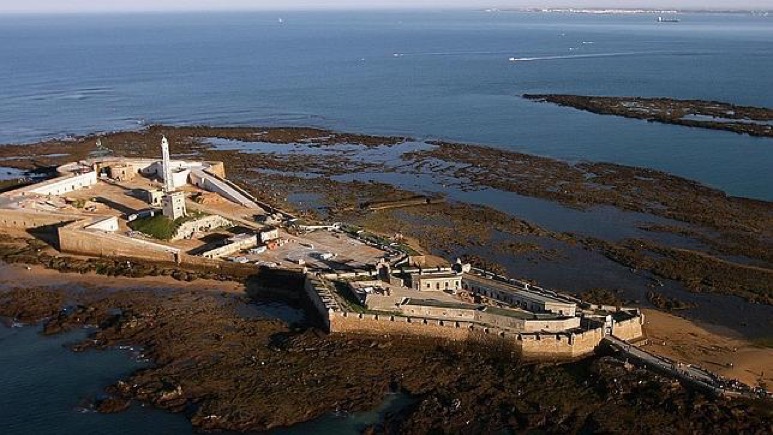
The present Castillo de San Sebastián dates from 1706, and today it is home to a lighthouse.
In 1625 there was another Anglo-Dutch expedition to attack Cádiz with another 100 ships and 15,000 men. It sounds like they failed miserably. The weather was bad, logistics poor, and most of the fleet was conscripted merchant ships. In addition Cádiz had substantially reinforced its defenses. Spanish accounts tell us that they had received more than 4,000 people in reinforcements. The attackers had gone to the same place as last time, and had in fact taken the fortress built there (it was later re-built). But in reality it was not part of the defenses of the city (it defended part of the port). The land forces then realised that they did not have any food or drink with them. The commander made the foolish decision to allow the men to drink from the wine vats found in the local houses. A wave of drunkenness ensued, with few or none of the force remaining sober. When the Spanish army arrived, they found over 1,000 English soldiers still drunk. Although every man was armed, not a single shot was fired as the Spanish put them all to the sword.
In 1639 it was decided to built a massive defensive wall against a land attack, the so-called Puerta de Tierra. In the city there is a Museo de Las Cortes de Cádiz (a topic in itself and treated on a different webpage) and a maqueta or large wooden model of 18th C Cádiz. Below we can see the extent of the defensive constructions at the time.

Cádiz grows and prospers
Backing away from the conflicts, storms, disease, ... progress in Cádiz was substantial. Population estimates exceeded 100,000 people for the late 17th C, including around 14,000 in nearby villages, etc. Ships carrying precious metals, and the commerce with the Americas, were valuable for all classes of society in the city. For example in the year 1684 the sum of 200,634,000 maravedises of silver was registered as arriving from the New World (this was a coin minted in the New World). This was equivalent to about 6 million reals or 18 tons of silver (possibly about $350 million in purchasing power today). And in 1664 the city gifted to the cathedral a silver monstrance weighing 1,528 marcos (equivalent to 350 kg).
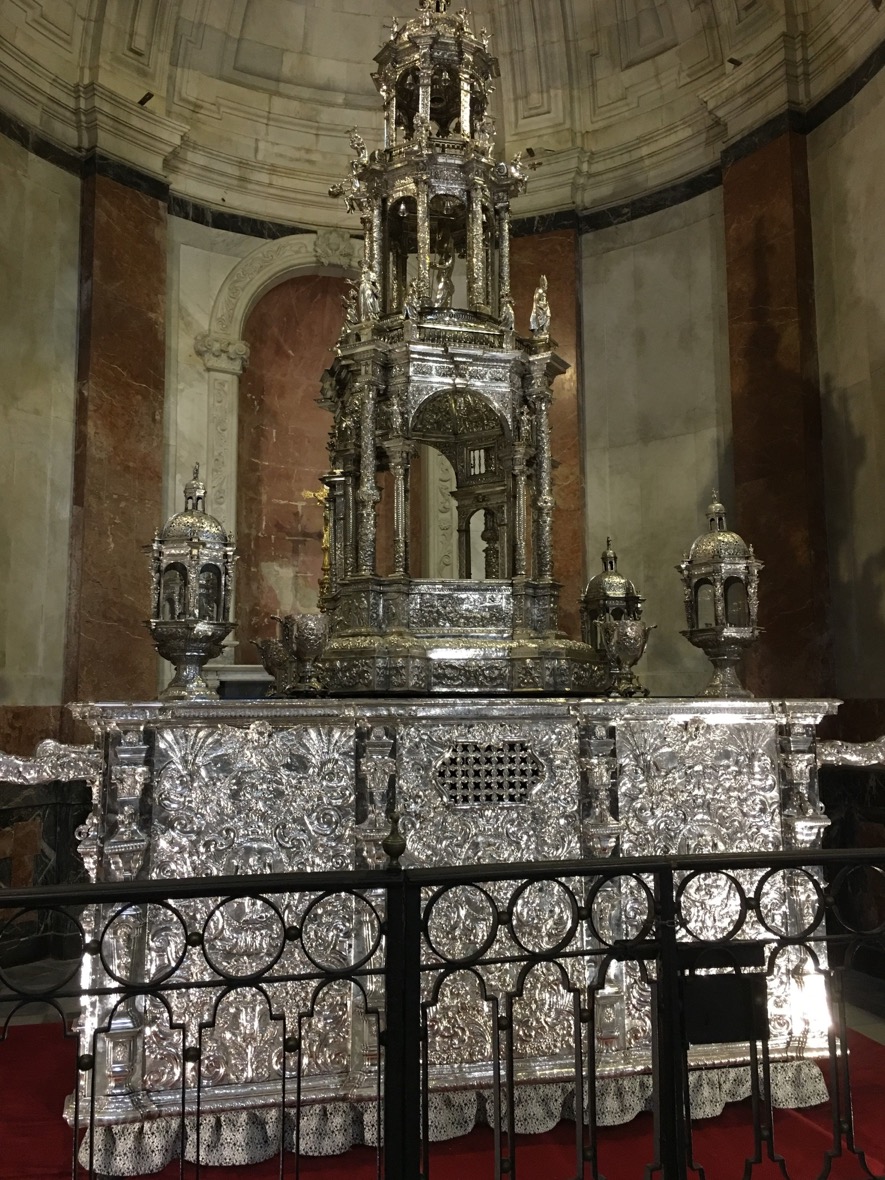
Through 1701-1714 there was the War of the Spanish Succession (La Guerra de Sucesión Española), in which Cádiz actively took the part (grandes servicios) of Felipe V (1683-1746). During the Battle of Cádiz in 1702 the Anglo-Dutch fleet turned up with 150 ships, including 50 warships, and about 14,000 men. After a complex decision process they decided to land miles away and captured Rota as a landing stage. As they moved toward Cádiz they found in Puerto Santa María warehouses full of goods, and wine and brandy (mostly owned by English and Dutch companies doing business under Spanish names). The army plundered everything included the convents and churches, thus alienating the local population. To cut a long story short the Anglo-Dutch forces took their time getting to Cádiz. A Cádiz that had started with just 300 poorly equipped men to defend the city, but given time they muster 500 good horsemen, and several thousand militia. The Anglo-Dutch forces were permanently harried, their communications cut, the weather was bad, and finally the whole thing ended in abject failure. After the signing of the peace treaty, Felipe V with his family visited Cádiz, and at the same time a fleet arrived from the Americas carrying 30 million pesos (which I think represent about 800 tons of silver). Despite the fact that the fleet was to go on to Sevilla, Cádiz decided to donate 50,000 pesos to the cost of the trip by Felipe V, and another 10,000 pesos to their children (Príncipe de Asturias y la Infanta).
During this time one of the ‘sons' of Cádiz, Andrés Matías de Pes Marzaraga (1653-1723), became Admiral of the Spanish fleet. He was also (Governor) Gobernador del Consejo de Indias (the most important institution for the administration of the Americas and Philippines). And it was he who convinced José Patiño y Rosales (1666-1736), the Spanish First Secretary of State (a kind of prime minister at the time), to decree in 1717 to move los tribunales de la Casa de Contratación from Sevilla to Cádiz, and to make Cádiz the only authorised port for trade with the Americas. This brought great wealth to the city.
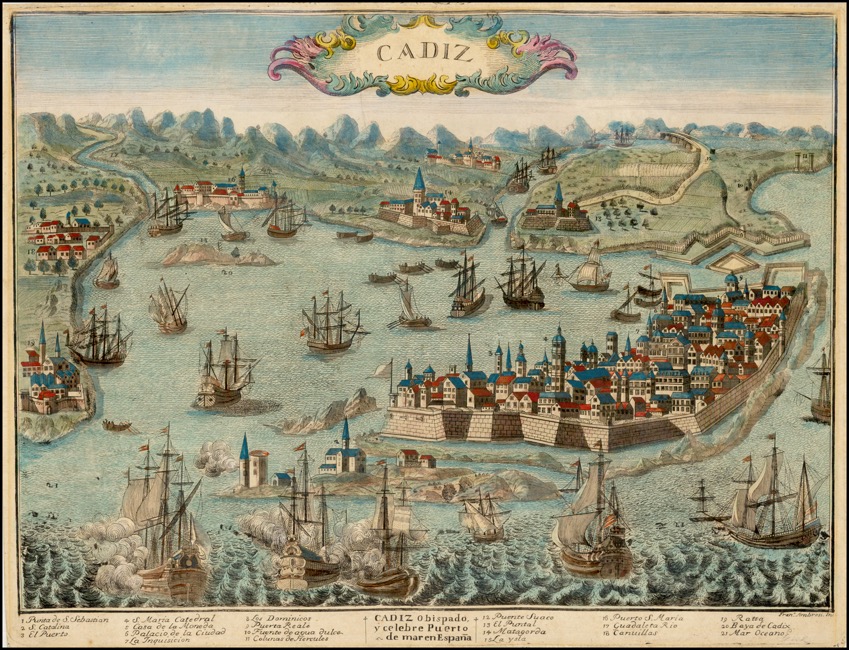
This is a 17th C engraving of Cádiz. First impressions are of a port constantly in activity, and constantly under attack. At the time the ‘port’ was essentially a protected bay where cargo would be discharged to small boats to be taken to warehouses.
In 1649 Cádiz was hit again with an epidemic that in two years killed more than 14,000 people. In 1671 the city was hit by a hurricane, resulting in 600 deaths and damage estimated at 150,000 ducados (>$20 million in today’s money).
Just to keep the gaditanos on the toes there was also the so-called War of the Reunions (1683-84) between France and Spain. It would appear that 60 ships turned up in front of Cádiz led by the Comte de Tourville, but as far as I can see nothing happened before a peace treaty was signed. And of course there was the Nine Year War (1688-1697) fought between the French and a Grand Alliance of the English, Spanish, Dutch, and even the Holy Roman Empire. Perhaps the most interesting reference during that period is that Cádiz became a hotspot of international intelligence gathering. The different consuls watched the movements of different nationals in the city, reported on ongoing wars, and looked for new sea routes. Cádiz being a small community had seen many different nationals integrate themselves into local society, and some of them were not above professing to be private citizens whilst actually worked for their home governments. For example it is well documented that the flow of information between Cádiz and Italy continued uninterrupted for many, many years.
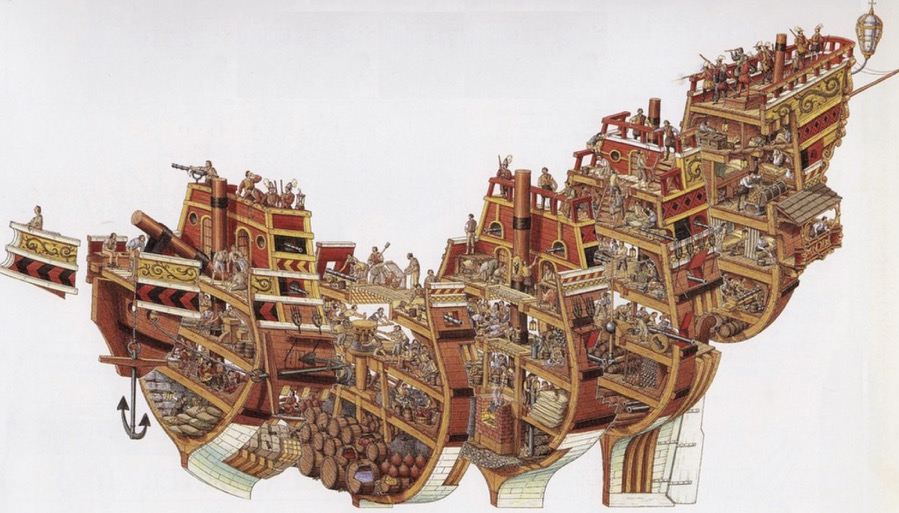
Once the Americas discovered, Spain needed ships able to make regular transoceanic voyages laden with cargo, and well defended against pirates. The answer was the galleon, and the design last for almost 250 years (through to 1814) and was copied by everyone. The Dutch enclosed a portion around the stern. The English made a race-built galleon with a sleeker hull.
These ships typically would have 30 m keels, a beam of 12 m, four masts, a weight of 500 tons, and carry 38 cannons (in later years some touched the 2,000 tons and carried more than 100 cannons). They might have a crew of 320 and carry another 100 soldiers. The Spanish galleon could have more than one deck of guns. You might need more than 70 people to man the guns, 50 to man the sails, and 50 to sail the ship (the others would be fighting fires, etc.). To build such a ship would need 2,000 trees (pine, cedar, oak, and mahogany). They remained slow and clumsy, and the living conditions were very, very primitive. They were easy to damage, but difficult to sink. Most were not lost in war, but simply due to bad weather. They were hand built, and usually had to travel with their own carpenters, sailmakers, and coopers. A flota might consist of 12 galleons and two dispatch boats, and some of the treasure galleons could carry in excess of 100 tons of cargo. One check on the cargo of a galleon sailing out of an African port showed that it was over-loaded by a factor of 10! The round trip to the Orient was the most dangerous. It would take 4 months, and one third of the crew would die of scurvy, epidemics, hunger, thirst, or exposure. Sir Francis Drake captured the San Felipe in 1587 with a cargo worth $35 million today. Piet Heyn succeeded in capturing every ship in a flota in 1628. The combined haul was 88.5 tons of silver, 70 kg of gold, 2,270 chests of indigo, 735 chests of cochineal, 37,375 hides, and 235 chests of sugar, spices, and pearls. The wreck of a Spanish galleon sunk by the English in 1804 was recently salvaged along the Portuguese coast. It contained 574,553 silver coins and 212 gold coins for a total of 16 tons, worth today $500 million.
Business as Usual
We have talked about trade with the Americas, and the importance of Cádiz. But what did they trade, and what was it worth? The exports were in order of importance: wool, Andalusian wines, olive oil, salt, aguardiente (a kind of strong alcoholic drink), and dried fruit. Imports in order of importance were: cacaos, añil (indigo), jalapa (which I think might mean tabasco), cochinilla (the dye carmine from the cochineal), cueros (leather), sugar, copper, tinted woods, and cotton. We must remember that precious metals went to Sevilla, but all other trading items went through Cádiz. Just for the years 1732 to 1776 the total trade passing through Cadiz was in excess of 147 million pesos (or the equivalent of nearly 4,000 tons of silver). My best estimate for that in terms of todays prices is $3.5 billion, or $80 million annually, and this does not include any domestic commercial activity.
For example, the fleet that entered Cádiz on the August 4, 1758 carried (for the King) more than 1 million pesos fuertes (25 tons of silver), 21,100 pesos gold (>570 kg gold), 30,898 quintal of copper (1,512 ton), and 40,998 quintals of (I think) exotic woods (2,006 tons). I’m not sure if their quintals is the same as our quintals today (because the figures look so excessive). In addition for traders in Cádiz the fleet carried a cargo 14,829,000 pesos fuertes (I’m not sure what that means, but my best estimate is 400 tons), and finally for other traders the fleet carried 19 million pesos of cargo (another 513 tons).
We have no doubt jumped over a number of fights and skirmishes between different European countries, but the next on our list is the Anglo-Spanish War (1796-1808). Yes, finally we have arrived at the famous Battle of Trafalgar (1805). I will look at Trafalgar on a separate webpage, but we can look at events that affected directly the city of Cádiz. For example we have the ‘derrota' in 1797 of a Spanish fleet of the Cabo de San Vincente. Spain lost 1,500 men simply due to the ineptitude of one of the commanders who had under his orders 24 ships and 12 frigates. It was not rare to see the people of Cádiz express their “deshonor”, and their “ódio” for all the fleet commanders.
It certainly did not help that in 1800 more than 40,000 people in Cádiz were affected by yellow fever, from which 7,387 died. And this led to an odd, and poorly documented story. For at the same time (naturally) the English fleet arrived with the firm intention to attack Cádiz. A General Sir Ralph Abercromby had orders to put Cádiz under siege, and the squadron of Captain Alexander Cochrane blockaded the port (he was quite a figure in his own right). Admiral Keith arrived from Gibraltar. In the different descriptions in English nothing is said of the yellow fever in Cádiz. People accused Admiral Keith of a lack of communication, indecision and negligence. It is said that the mission failed because the leaders were too slow in getting the men and boats ashore. Admiral Keith is said not to have taken a positive and decisive role in the siege, which everyone thought was uncharacteristic. Fortunately his career was not tarnished by this event. But in the Spanish texts the situation is (sometimes, but not always) described differently. The city commander (Capitán General) at the time, Tomás de Morla y Pacheco, sent a message to the English Admiral Keith suggesting to abandon the attack. This would avoid ulterior deaths and also avoid infecting the English forces. Admiral Keith is said to have replied that it was a good thing to not increase the calamities befallen the city and he asked that all the Spanish ships of war be removed from the bahía. Our city commander replied that it was a dishonest proposal, and that his suggestion was one to be understood between two men of honour. The English descriptions suggest some technical reasons for the fleet leaving Cádiz, whereas the Spanish texts simply say that through the fortitude of the Spanish commander and the generosity of the Admiral, Cádiz was saved from additional pain and destruction.
The so-called Anglo-Spanish War (1796-1808) was in fact divided into two parts, 1796-1802 and 1804-1808. Unfortunately Cádiz figures again because on the last day of the conflict in 1802 they lost to the English 3 ships and 2,600 men.
Cádiz was both a commercial and military port, but war was bad for business. Cádiz suffered not because of the military campaigns, and because of the lost commerce with the Americas. They estimated that the war with France had cost them in 1793 more than 18 million duros, and the one with the English cost another 29 million duros. A duros was until recently a 5 pesetas coin, but could also have been a 8-real silver coin containing about 25 g of silver.
Cádiz Moved into the 19th C
A visitor to Cádiz in the late 18th C described the city as a place where all available space was used, but where the roads were large “anchas” (everything is relative) and paved, and houses were “grandes, cómodas, frescas y bien distribuidas”. Another visitor in 1830 said that the city was well built, and everyone agreed that it was a fine place but built within a small space. It was equally true that the city lived on trade, and except for its limited fishing sector, had no domestic activity. But it was the mercantile capital of Spain. I am less than convinced about the city being a nice place to live, because in 1810 there was an outbreak of typhus, in 1811 one of yellow fever, in 1812 one of smallpox, and in 1813 and again in 1819 yellow fever. In 1819 there were 6,200 deaths, so by 1837 it is said that the population had dropped to only 55,000 (and this stayed stable through to 1857).
We now turn to a moment that certainly has defined Cádiz in the minds of most Spanish. In 1807 another (yet another) military conflict exploded between the First French Empire (Napoleon) and (this time) the allies Spain, United Kingdom, and Portugal. This was the so-called Peninsular War (1807-1814), which was part of a larger conflict entitled the Napoleonic Wars (where Napoleon was finally defeated at Waterloo in 1815). The French occupation destroyed the Spanish centralised administration and government, which fragmented into quarrelling provincial juntas. In 1810, a reconstituted national government, the Cádiz Cortes, effectively a government-in-exile, fortified itself in Cádiz but could not raise effective armies because it was besieged by 70,000 French troops.
I will treat separately the events of this period, but it is worthwhile mentioning that the Cádiz Cortes produced in 1812 the first Spanish Constitution. When Ferdinand VII was restored to the throne he initially promised to uphold the new constitution, but he then abolished it a few week later. Under popular pressure it was restored between 1820-1823, but after the intervention of the French in support of Ferdinand VII he regained his absolutist powers, and took his revenge on liberals and constitutionalists. Cádiz again played a central role. It was in Cádiz that Fafael del Riego, together with other liberal officers, started the mutiny in 1820 that finally lead to Trienio liberal.
This constitution is still evoked today as “La Pepa” because it was adopted on Saint Joseph’s Day (San José, March 19, 1812), and “Pepa” being the nickname for Josephine.

La Promulgacíon de la Constitución de 1812, by Salvador Vinegar.
Cádiz - No Longer an Actor on the World Stage
In 1823 Cádiz was considered unique in Spain because of the large number of foreigners passing through the port. It was considered one of the most ‘agradables' cities in Europe. The gaditanos did not travel much, they liked to live in society, to have fun, and they were “franco y afablegente culta”. The "gente culta’’ were affectionate, friendly, and 'gracioso'. Everyone else was rude, jocular, vain, smug, braggart, idle, and enjoyed smuggling.
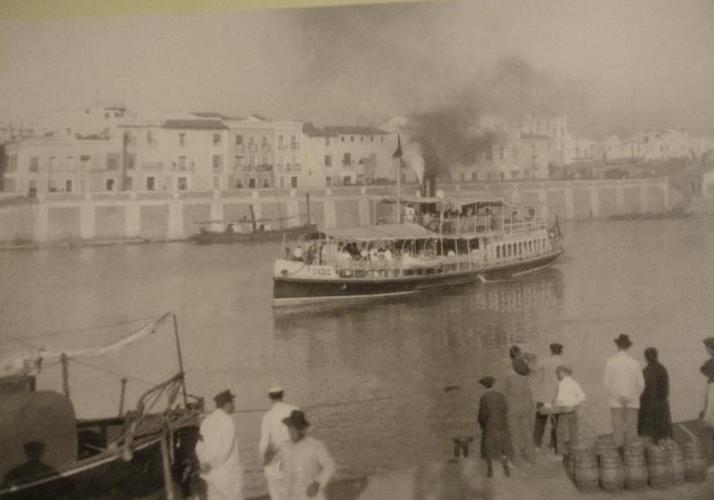
We jump forward somewhat to a period when you could make the trip between Sevilla and Cádiz in a small steamboat, I think it must be around 1840. For the rich it had a forward cabin with 30 or 40 fixed mahogany arm-chairs, and for the poor the aft cabin was a ‘filthy hole’. Our traveller tells us that Cádiz had been a place of much consequence, because of its commerce and because it could be defended against foreign invasion. With its limited size it did not have “those extensive public walks and gardens which give such a charm to other Spanish cities”. However, the cleanliness, the external beauty of the houses, the white walls, the projecting balconies, and the flowering shrubs, all combined to make it one of the handsomest cities of Europe. One writer, Charles Rockwell (his book was first published in 1842), tells us that before 1800 Cádiz had a population of more than 80,000, but in 1800 10,000 died of the plague. When Bonaparte overran Spain, Cádiz held strong, and much of the Spanish nobility took asylum there. The city grew to 150,000 and our authors tells us that “the degree in which licentiousness was then introduced and prevailed throughout all ranks of society was truly appalling”. At the time of our authors visit (1830-1840) the population of Cádiz had dropped to 43,000, and its principle activity was shipping Xerez (Sherry) to America, and receiving both large quantities of tobacco and staves from which to make wine-casks. It would appear that trading in Sherry was a very lucrative business, with one agent saying that he had more than $200,000 worth of wine in the hands of a single agent in London. Our author estimated that Cádiz shipped out to America annually about 60,000 butts of wine (a butt was about 600 bottles), for a value in excess of $6 million (worth about $500 to $600 million today). And there were about 150,000 butts stored in reserve in Jerez de la Frontera. Our author was able to add much information on the way Cádiz had changed between 1776 and 1835. In 1776, 949 vessels entered the port of Cádiz, of which 265 were French. In 1777, there were 935, of which 280 were French. In 1835, there were 2,699 arrivals in Cádiz, of which 2,176 were Spanish vessels, most of them of small tonnage. In addition 286 were English, 79 American, 22 French, and 34 Russian. In 1834 the 240 English vessels had carried 31,899 tons, and had been manned by 1,968 seamen. In the same year, 71 American vessels had arrived, with 20,630 tons, and manned by 941 seamen.
It was again in Cádiz that Admiral Juan Bautista Topete mutinied, and with other generals denounced the government. The result was that Queen Isabel II (1830-1904) went into exile in France from 1868. Finally in 1870 Amadeo of Savoy was elected King, but he only last two years. The first Spanish Republic did not last much longer, before they turned to the son of Isabel, King Alfonso XII (1857-1885).
We now jump forward to the years 1840-1900. For example we are informed that the humidity can make the summers oppressive, and along with poor drainage and “masses of rotting seaweed” it makes for an unhealthy atmosphere. The death-rate was high due to the bad water supply, with water being stored in cisterns on rooftops. At the time all the buildings were painted white, which to some produced a disagreeable glare in summer. The streets were clean, Italian marble was much in use, and the marine promenades were much appreciated. At that time the bullring could seat 12,000 people, and the light-house of San Sebastian stood 60m tall. During the period 1830-1860 roads were widened, squares were built (e.g. Plaza de Mina in 1836) and others paved, and gardens were created. Observers noted that the city provided gratuitous instruction for children, academies for further education, a nautical school, a theological seminary and even a medical school. Of course the city also had a prison with a 1,000 inmates, a foundling institution, and a lunatic asylum.
In 1903 Cádiz was no longer ranked as a major marine city, its habour was antiquated, and communication with the mainland was limited to one road and a single rail-line. Nevertheless people were content. Several great shipping lines called, shipbuilding continued in the nearby ports, and wine, salt, olives, figs, canary-seed, and ready-made corks were exported. Fuel, iron and machinery, and building materials were imported. American oak staves for casks were still imported.
But as different Spanish colonies gained independence, trade will them slowed. Trade with Cuba and Porto Rico collapsed after the Spanish-American War of 1898 (yes, yet another war). In 1928 Cádiz was declared a tax free warehousing port, but that privilege was withdrawn in 1932. In 1947 a major explosion of a powder magazine destroyed a part of the city extramuros (the areas has since been rebuilt). In 2002 a new bridge was opened connecting Cádiz with Puerto Real, and there a second bridge has recently been completed. A major investment in a new container port is also ongoing.
In decline, after its involvement in the War of Independence (the name given to the Peninsular War) and sunk after the loss of Cuba, the city initially did not stop growing in population (benefiting from the rural exodus), until the early 1990’s. However during the period 1996-2010, around 20,000 people have left the city of Cádiz, most for the San Fernando beach area.
Modern Cádiz is best seen through my different webpages on the cities barrios and attractions.